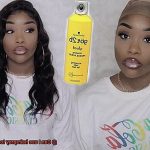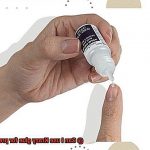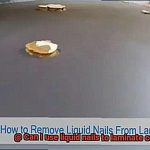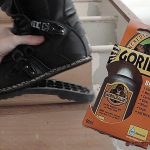When it comes to unleashing our creativity, hot glue is like a trusty sidekick for crafters and DIY enthusiasts. But what about using Gorilla Hot Glue on fabric? Well, fear not. This adhesive powerhouse has got your back when it comes to fabric projects. With its mighty strength, Gorilla Hot Glue forms a bond that can withstand the test of time (and all those accidental tugs). However, before you dive into gluing frenzy, there are a few things to keep in mind. We’ll be talking safety precautions, application techniques, and even the specific fabrics that play well with this glue. So buckle up and let’s unravel the secrets of using Gorilla Hot Glue on fabric – because your projects deserve nothing but the best.
What is Gorilla Hot Glue?
Contents
- 1 What is Gorilla Hot Glue?
- 2 Is Gorilla Hot Glue Suitable for Fabric?
- 3 Factors to Consider When Using Gorilla Hot Glue on Fabric
- 4 Preparing the Fabric for Application of Gorilla Hot Glue
- 5 Tips and Techniques for Enhancing the Bond between Fabric and Gorilla Hot Glue
- 6 Alternatives to Using Gorilla Hot Glue on Fabric
- 7 Conclusion
Gorilla Hot Glue is a popular adhesive product known for its strength and versatility. It is a type of hot melt adhesive that comes in solid sticks and can be used with a hot glue gun. When heated, the glue melts into a liquid state, allowing it to bond different materials together.
One of the key features of Gorilla Hot Glue is its exceptional holding power. It is designed to provide a strong and durable bond, making it suitable for a wide range of applications. Whether you are working with wood, metal, plastic, or fabric, Gorilla Hot Glue can provide a reliable hold.
The composition of Gorilla Hot Glue includes synthetic polymers and additives that give it its unique properties. These ingredients allow the glue to melt at high temperatures and solidify quickly upon cooling. This quick-setting characteristic is advantageous as it reduces the waiting time for the adhesive to dry.
Gorilla Hot Glue is also known for its versatility. It can be used on various surfaces and materials, including fabric. However, it is important to note that not all fabrics are compatible with Gorilla Hot Glue. Delicate or heat-sensitive fabrics may not react well to the high temperatures required for the glue to melt.
When using Gorilla Hot Glue on fabric, it is recommended to conduct a small test on an inconspicuous area first. This will help determine if the glue adheres well without causing any damage or discoloration to the fabric. Additionally, applying the glue sparingly can help avoid any excess seeping through the fabric.
Is Gorilla Hot Glue Suitable for Fabric?
Crafting with fabric requires careful consideration of the adhesive used, and Gorilla Hot Glue is no exception. To determine whether it is suitable for fabric, there are several key points to keep in mind.
First and foremost, the type of fabric plays a crucial role. Delicate or lightweight fabrics like silk or chiffon should be handled with care, as the high temperature of the hot glue can easily damage or burn them. Instead, Gorilla Hot Glue is better suited for heavier fabrics such as denim or canvas that can withstand the heat.
Additionally, the specific application of the fabric should be considered. If you are looking to create a permanent bond between fabric pieces, Gorilla Hot Glue may not be the best choice. While it provides a strong initial bond, it may not hold up well over time, especially with repeated washing or exposure to moisture.
However, for temporary or decorative purposes, Gorilla Hot Glue can be suitable for fabric. It can effectively attach embellishments, trims, or appliques onto fabric surfaces. To ensure a smooth finish, it is important to apply the glue in a thin and even layer, avoiding any unsightly bumps or lumps.
When using Gorilla Hot Glue on fabric, safety precautions are essential. Follow the manufacturer’s instructions carefully, using the appropriate temperature setting on your glue gun and working in a well-ventilated area. Additionally, protect your work area with a heat-resistant surface or mat to prevent accidental damage.
Factors to Consider When Using Gorilla Hot Glue on Fabric
Crafting with fabric requires careful consideration of adhesive choices, and while Gorilla Hot Glue may not be the perfect match for delicate fabrics like silk or chiffon, it can work wonders on heavier materials like denim or canvas. Just like a sturdy seam, Gorilla Hot Glue can securely attach embellishments and appliques to fabric surfaces, creating a temporary bond that adds flair to your creations.
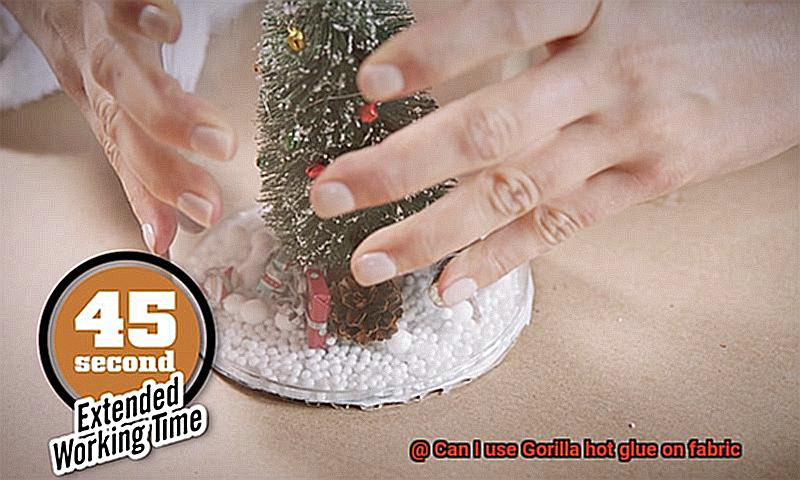
However, it’s important to remember that this glue may not hold up well over time or with repeated washing, so use it wisely.
Think of Gorilla Hot Glue as a trusty sidekick for your fabric crafts – it’s there to lend a helping hand when you need it, but make sure to follow safety precautions and handle with care.
Here are some factors to consider when using Gorilla Hot Glue on fabric:
- Fabric Type: The type of fabric you are working with plays a crucial role in determining whether Gorilla hot glue is suitable. Some fabrics, such as cotton, polyester, and denim, tend to work well with hot glue. However, delicate fabrics like silk or satin may be damaged by the high heat of the glue gun.
- Temperature Sensitivity: It is important to consider the temperature sensitivity of the fabric. Gorilla hot glue typically requires a high temperature to melt and bond properly. If your fabric is sensitive to heat, it may warp or discolor when exposed to the hot glue. In such cases, it is advisable to test a small, inconspicuous area before proceeding with your project.
- Bond Strength: Gorilla hot glue is known for its strong bond, but the strength of the bond may vary depending on the fabric type. Rough and porous fabrics tend to provide better adhesion compared to smooth or slippery fabrics. When working with delicate or lightweight fabrics, it is recommended to apply the glue sparingly to avoid any visible residue or stiffness.
- Washability: If you plan on washing your fabric item, it is essential to consider the washability of the Gorilla hot glue. While the glue is generally resistant to water and washing, it may not withstand frequent laundering or harsh detergents. It is advisable to follow the manufacturer’s instructions for proper care and maintenance of the glued fabric.
- Application Technique: The technique used for applying Gorilla hot glue on fabric can greatly impact the final result. It is recommended to apply the glue in thin lines or dots rather than spreading it over a large area. This helps in achieving better control and reducing the chances of excess glue seeping through the fabric or creating unsightly lumps.
- Drying Time: Gorilla hot glue typically dries quickly, but the drying time can vary depending on factors such as temperature and humidity. It is important to allow sufficient drying time before manipulating or handling the glued fabric to ensure a strong and durable bond.
- Safety Precautions: When working with any hot glue, including Gorilla hot glue, it is essential to take necessary safety precautions. Use the glue gun in a well-ventilated area and protect your hands from burns by using a heat-resistant glove or finger protectors. Additionally, keep the glue gun away from children and pets to avoid accidents.
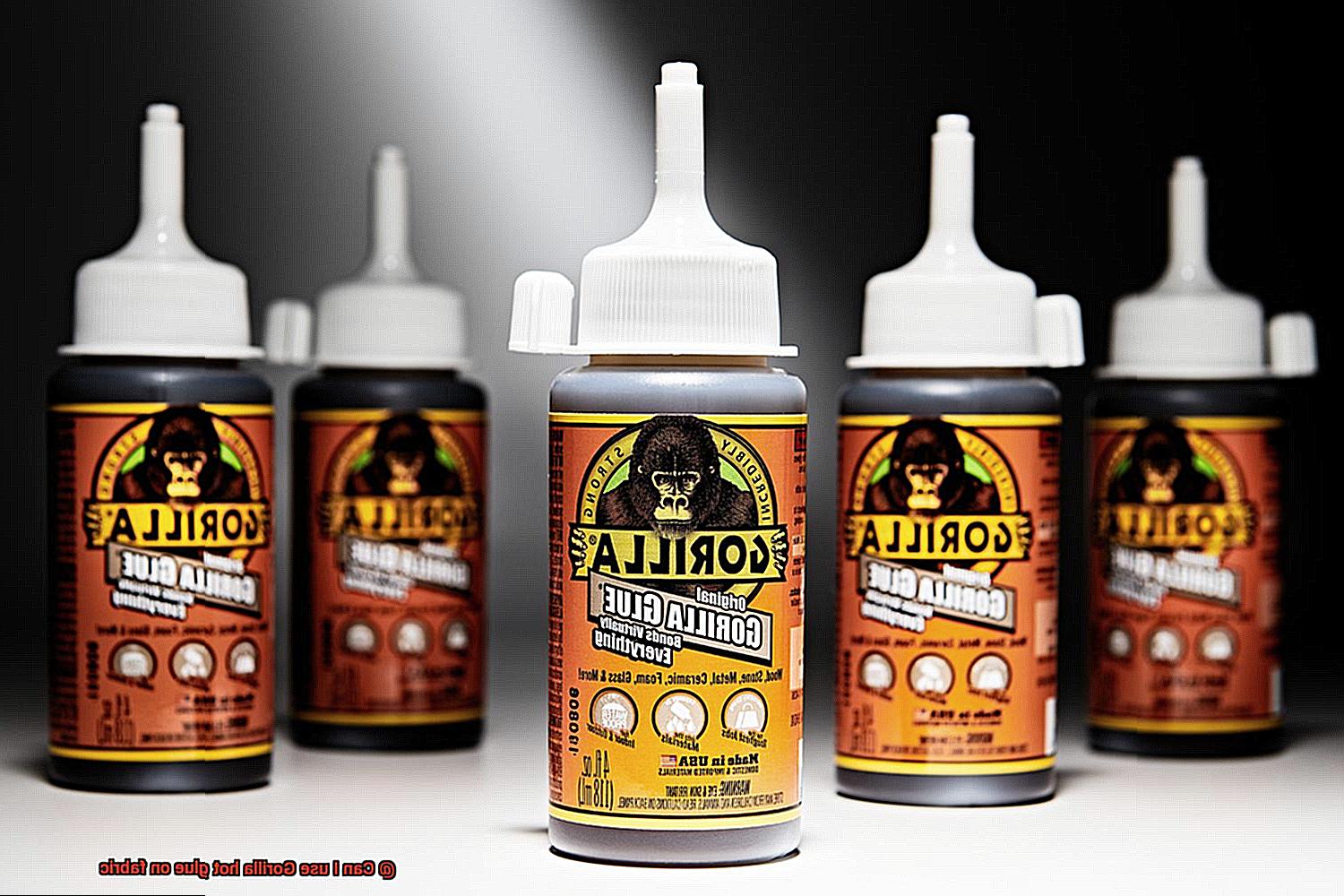
Preparing the Fabric for Application of Gorilla Hot Glue
Preparing fabric for the application of Gorilla Hot Glue is a crucial step in ensuring a bond that is not only strong but also long-lasting. To achieve this, there are several important considerations to keep in mind.
First and foremost, the fabric must be thoroughly cleaned to eliminate any dirt, dust, or oils that may hinder the adhesive’s ability to bond effectively. This can be done by gently washing the fabric with mild soap and water or spot cleaning specific areas if necessary. It is vital to rinse off all soap residue and allow the fabric to dry completely before proceeding with the glue application.
Different fabrics may require different preparation methods. Delicate or sensitive fabrics like silk or lace require extra caution to avoid damaging the material. Test a small area of the fabric with Gorilla hot glue beforehand to ensure it doesn’t cause any discoloration or harm.
Coatings or finishes on some fabrics can also impede proper adhesion. In such cases, lightly sanding or roughening the fabric’s surface can enhance the bond.
Texture plays a role too. Smooth fabrics may not provide enough surface area for effective adhesion. Creating small punctures or scratches on the fabric’s surface using a needle or sandpaper can increase adhesion.
Before applying Gorilla Hot Glue to your final project, it is advisable to pre-test your application method on a scrap piece of fabric. This allows you to ensure that you are using the correct amount of glue and that it bonds securely without any unwanted effects on your project.
Tips and Techniques for Enhancing the Bond between Fabric and Gorilla Hot Glue
Clean the fabric surface
Before applying Gorilla Hot Glue, it’s crucial to clean the fabric surface thoroughly. Any dirt, dust, or debris on the fabric can interfere with the adhesive’s effectiveness. Use a lint roller or a soft cloth to remove any loose fibers or particles from the fabric.
Pre-test on a small area
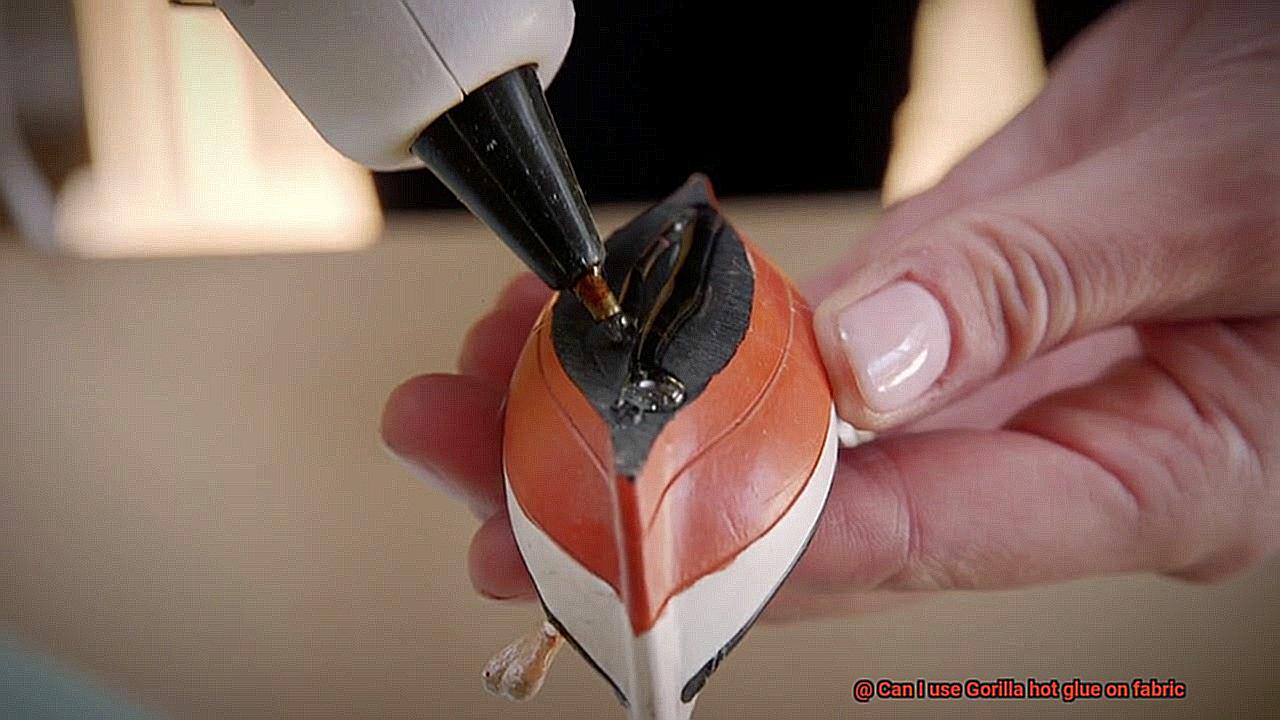
Conduct a pre-test on a small, inconspicuous area of the fabric before gluing the entire piece. This will help determine if the hot glue adheres properly to the fabric without causing any damage or discoloration. Apply a small amount of glue and press it firmly together. Let it dry completely and check if the bond is strong.

Adjust temperature setting
Gorilla Hot Glue guns usually come with adjustable temperature settings. For fabric, it is advisable to use a low to medium temperature setting. High temperatures can sometimes cause the fabric to burn or melt, leading to an ineffective bond. Experiment with different temperature settings on scrap pieces of fabric to find the optimum one for your specific project.
Apply in thin, even lines
When applying Gorilla Hot Glue to fabric, use thin and even lines instead of large blobs of glue. Thin lines distribute the adhesive more evenly and reduce the risk of excessive glue seeping through the fabric or creating unsightly bumps.
Work quickly
Gorilla Hot Glue dries relatively quickly, so it’s essential to work swiftly once the glue is applied to the fabric. Waiting too long before pressing the fabrics together can result in a weaker bond as the glue starts to cool and harden.
Apply pressure during bonding
To enhance the bond between fabric and hot glue, apply pressure on the glued areas. Use your fingers or a tool to press the fabrics firmly together. The pressure helps the glue penetrate the fibers of the fabric, resulting in a stronger bond.
Allow sufficient curing time
After bonding the fabric with Gorilla Hot Glue, allow enough time for the adhesive to cure properly. Follow the manufacturer’s instructions for the recommended curing time, usually between 24 to 72 hours. Avoid handling or stressing the glued area until it has fully cured to ensure maximum strength.
Consider fabric type and thickness
Different types of fabric may require different techniques for optimal bonding with Gorilla Hot Glue. Delicate or synthetic fabrics may need extra care to prevent damage during the gluing process. Additionally, thicker fabrics may require more glue or longer curing times to achieve a strong bond.
Alternatives to Using Gorilla Hot Glue on Fabric
Alternatives to Using Gorilla Hot Glue on Fabric:
- Fabric Glue: Designed for fabric bonding, provides a strong and flexible hold, available in different formulas, easy to apply with precision.
- Fusible Web: Creates a permanent bond between fabrics, activated by heat with an iron, commonly used in sewing projects like appliqués or hemming.
- Sewing Techniques: Provides a secure and durable bond, suitable for delicate fabrics, requires sewing skills and equipment.
- Double-Sided Tape with Fabric Adhesive: Quick and easy to use, suitable for temporary bonding or holding fabric in place during sewing projects.
- Spray Adhesive: Provides a strong bond, allows for repositioning before setting permanently, commonly used in upholstery projects or working with larger fabric pieces.
- Epoxy Adhesive: Suitable for heavy fabrics or materials requiring a stronger bond, known for durability and versatility.
By5c2aVTohI” >
Conclusion
In conclusion, yes, you can absolutely use Gorilla Hot Glue on fabric. But before you dive in, there are a few things to keep in mind. The type of fabric you’re working with is crucial. Delicate silk or chiffon may not fare well under the intense heat of the glue gun, so it’s best to stick to heavier fabrics like denim or canvas.
Before going all-in on your fabric project, it’s wise to conduct a small test on a hidden area first. This way, you can ensure that the glue adheres securely without leaving any unsightly damage or discoloration behind. And remember, less is more when it comes to applying the glue – thin lines are your friend here.
While Gorilla Hot Glue provides an initial strong bond, it may not stand the test of time or repeated washing. So if you’re looking for a long-lasting solution, it’s better suited for temporary or decorative purposes. Think attaching embellishments or appliques onto your fabric surfaces.
Of course, safety should always be a priority when working with any kind of adhesive. Make sure to use the appropriate temperature setting on your glue gun and work in a well-ventilated area. And don’t forget to protect your workspace with a heat-resistant mat – nobody wants accidental glue mishaps ruining their project.
If Gorilla Hot Glue isn’t quite right for your fabric endeavor, fear not. There are plenty of alternative options available. From fabric glue and fusible web to sewing techniques and double-sided tape with fabric adhesive – there’s something out there for every project. You could even try spray adhesive or epoxy adhesive if those suit your needs better.
To sum it all up, while Gorilla Hot Glue can indeed be used on fabric, it’s essential to consider both the specific type of fabric and the application technique you’ll be using.


